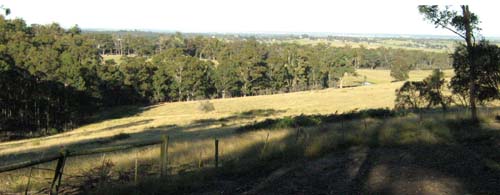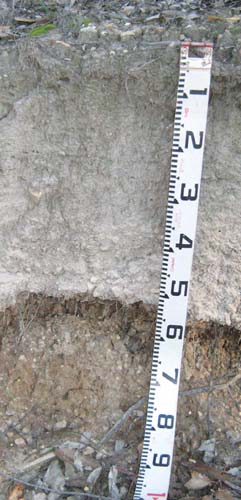EGS266
Location: Mount Taylor
Australian Soil Classification: Bleached-Sodic, Magnesic, Brown CHROMOSOL
Map Unit: Deadhorse (Component 2)
Previous Site Name: EG266
General Landscape Description: Rolling low hills.
Site Description: ENE slope, 13% slope
Native Vegetation: Lowland herb rich forest
Geology: Devonian granite (porphyry)

EG266 - landscape
Soil Profile Morphology:
Surface Soil
| A1 | 0 – 10 cm | Dark grey (7.5YR4/1); sandy loam; weak coarse angular blocky structure; very firm dry; pH 5.6; clear change to: |  No soil pit photo available, but this was taken on a road exposure nearby. The surface soil is deeper than the sampled soil |
| A2 | 10 – 45 cm | Pale brown (10YR6/3), conspicuously bleached (7.5YR8/1); loamy sand; massive; pH 5.7; abrupt change to: | |
| Subsoil | |||
| B21 | 40 – 90 cm | Greyish brown (10YR5/2), common (10-20%) coarse (15-30 mm) yellowish brown (10YR5/6) distinct mottles; medium clay; strong very coarse angular blocky structure parting to fine angular blocky; strong consistence dry; very few (<2%) rounded cobbles (60-200 mm); pH 5.5; diffuse change to: | |
| B22 | 90 – 120 cm | Dark greyish brown (10YR4/2), many (20-50%) coarse (15-30 mm) yellowish brown (10YR5/8) distinct mottles; medium clay; strong coarse angular blocky structure; strong consistence dry; very few (<2%) rounded cobbles (60-200 mm); pH 5.3; diffuse change to: | |
| B23 | 120 – 170 | Light grey (10YR7/2), few very coarse (>30 mm) reddish yellow (5YR6/8) mottles; medium clay; coarse prismatic structure; very strong dry; few rounded cobbles. |
Key Profile Features:
- Strong texture contrast between the surface (A) horizons and the subsoil (B) horizon
- Strongly bleached subsurface soil (A2) horizon.
Soil Profile Characteristics:
pH | |||
Surface soil (A1 horizon) | Moderately Acid | Non-Sodic | None |
Subsoil (B21 horizon) | Strongly Acid | Non-Sodic | Slight1 |
Deeper subsoil (B22 horizon) | Strongly Acid | Sodic | Slight1 |
Chemical and Physical Analysis:
Horizon | Horizon Depth (cm) | pH (water) | pH CaCl2 | EC dS/m | Organic Carbon % | Total Nitrogen % | Exch. Acididty meq/100g | Exchangeable Cations | Coarse Sand (0.2-2.0 mm) % | Fine Sand (0.02-0.2 mm) % | Silt (0.002-0.02 mm) % | Clay (<0.002 mm) % | Field cap. % w/w | Wilt. point % w/w | |||
Ca | Mg | K | Na | ||||||||||||||
meq/100g | |||||||||||||||||
A1 | 0-10 | 5.6 | 4.7 | <0.05 | 2.9 | 0.17 | 9 | 56 | 2.2 | 1.2 | 0.3 | 30<0.1 | 36 | 17 | 10 | 27 | 6.1 |
A2 | 10-45 | 5.7 | 4.7 | <0.05 | 4.5 | 45 | 0.4 | 0.5 | <0.1 | 34<0.1 | 35 | 25 | 7 | 15.7 | 3 | ||
B21 | 45-90 | 5.5 | 4.2 | 0.06 | 12 | 220 | 0.4 | 4 | 0.2 | 190.5 | 22 | 14 | 44 | 29.1 | 16.8 | ||
B22 | 90-120 | 5.3 | 4.3 | 0.15 | 9.2 | 160 | 0.1 | 5.9 | 0.2 | 191 | 21 | 16 | 45 | 37.1 | 17.8 | ||
Management Considerations
Whole profile
- On the assumption the roots can extract the water in the top 45 cm of the soil, the plant available water capacity is very low, estimated at 40 mm.
Surface (A) horizons
- The surface soil is moderately acidic and, because it is also moderately high in aluminium, lime application may be of benefit.
- Potassium is deficient and a response to potassium fertiliser is likely. This would particularly apply if pasture has been baled and removed from the site.
- The nutrient holding capacity of the soil is very low (based on the sum of the basic cations).
Subsoil (B) horizons
- Based on the sum of the basic cations, the subsoil has an extremely low nutrient holding capacity.
- The subsoil is sodic and strongly dispersive. The risk of gully and tunnel erosion is high in such soils.
- The level of exchangeable aluminium is high in the subsoil and would have a significant effect on species sensitive to aluminium.
Profile Described By: Ian Sargeant (2011).


